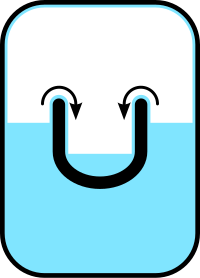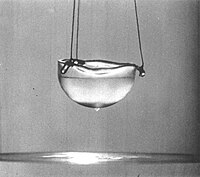Rollin film


A Rollin film, named after Bernard V. Rollin, is a 30 nm-thick liquid film of helium in the helium II state. It exhibits a "creeping" effect in response to surfaces extending past the film's level (propagation). Helium II can escape from any non-closed surface via creeping toward and eventual evaporation from capillaries of 10−7 to 10−8 meters or greater.
Rollin films are involved in the fountain effect where superfluid helium leaks out of a container in a fountain-like manner. They have high thermal conductivity. If not for its evaporation in the presence of heat, a Rollin film would have a very low index of refraction and would be nearly transparent (helium I has an index of refraction of 1.026).
The ability of superfluid liquids to cross obstacles that lie at a higher level is often referred to as the Onnes-Effect, named after Heike Kamerlingh Onnes. The Onnes-Effect is enabled by the capillary forces dominating the gravity- and viscous forces.
Waves propagating across a Rollin film are governed by the same equation as gravity waves in shallow water, but rather than gravity, the restoring force is the Van der Waals force. These waves are known as third sound.
See also
References
- Fairbank H.A.; Lane C.T. (October 1949). "Rollin Film Rates in Liquid Helium". Physical Review. 76 (8): 1209–1211. doi:10.1103/PhysRev.76.1209.
{{cite journal}}: Unknown parameter|month=ignored (help)CS1 maint: date and year (link) CS1 maint: multiple names: authors list (link) - B.V. Rollin and F. Simon (1939). "On the "film" phenomenon of liquid helium II". Physica. 6 (2): 219–230. doi:10.1016/S0031-8914(39)80013-1.
{{cite journal}}: Check date values in:|year=/|date=mismatch (help)
